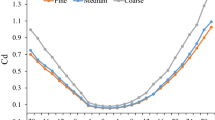Abstract
Mechanical constraints are one factor that shapes organisms' behavior and morphology. Therefore, elucidating these biomechanics is essential for discovering unknown functions of organisms. The cephalofoil of hammerhead sharks (Sphyrnidae) has long been discussed as representative of the organism's unique morphology and function. While the physiological benefits of cephalofoil are becoming clearer, their kinematic function remains to be elucidated in some areas. Scalloped hammerheads (Sphyrna lewini) have been shown to receive significant hydrodynamic drag during straight swimming due to cephalofoil. In contrast, S. lewini is known to exhibit excellent turning ability, but the hydrodynamic effects of the cephalopod foil during turning have not been clarified. This study performed a numerical fluid dynamics analysis on a simplified 3D model of a cephalofoil to simulate its turning and swinging behavior. The results show that the cephalofoil shape reduces the moment from the fluid by reducing the separation of the flow during turning. The study also suggested that having a cephalofoil creates a trade-off between the efficiency of swimming straight and the ability to turn. This study contributes to our understanding of the function of the cephalofoil in hammerhead sharks and to a deeper understanding of their ecology.








Similar content being viewed by others
References
Basri EI, Basri AA, Ahmad KA (2023) Computational fluid dynamics analysis in biomimetics applications: a review from aerospace engineering perspective. Biomimetics 8:319
Bradney DR, Davidson A, Evans SP, Wueringer BE, Morgan DL, Clausen PD (2017) Sawfishes stealth revealed using computational fluid dynamics. J Fish Biol 90:1584–1596
Brennen C (1982) A review of added mass and fluid inertial forces. Technical Report CR 82.010. Naval Civil Engineering Lavoratorvy, Port Hueneme
Demuth OE, Herbst E, Polet DT, Wiseman ALA, Hutchinson JR (2023) Modern three-dimensional digital methods for studying locomotor biomechanics in tetrapods. J Exp Biol 226(Suppl 1):jeb245132
Feng YK, Liu HX, Su YY, Su YM (2020) Numerical study on the hydrodynamics of C-turn maneuvering of a tuna-like fish body under self-propulsion. J Fluids Struct 94:102954
Ferrón HG, Martínez-Pérez C, Rahman IA, Selles de Lucas V, Botella H, Donoghue PCJ (2020) Computational fluid dynamics suggests ecological diversification among stem-gnathostomes. Curr Biol 30:4808–4813
Froese R, Pauly D (eds) (2023) FishBase. World Wide Web electronic publication. Sphyrnidae summary page. https://www.fishbase.se/summary/FamilySummary.php?ID=12. Accessed 8 March 2024
Gallagher AJ, Hammerschlag N, Shiffman DS, Giery ST (2014) Evolved for extinction: the cost and conservation implications of specialization in hammerhead sharks. Bioscience 64:619–624
Gallagher AJ, Klimley AP (2018) The biology and conservation status of the large hammerhead shark complex: the great, scalloped, and smooth hammerheads. Rev Fish Biol Fish 28:777–794
Gardiner JM, Atema J (2010) The function of bilateral odor arrival time differences in olfactory orientation of sharks. Curr Biol 20:1187–1191
Gaylord MK, Blades EL, Parsons GR (2020) A hydrodynamics assessment of the hammerhead shark cephalofoil. Sci Rep 10:14495
Ghoreyshi M, Darragh R, Harrison S, Lofthouse AJ, Hamlington PE (2017) Canard–wing interference effects on the flight characteristics of a transonic passenger aircraft. Aerosp Sci Technol 69:342–356
Hedrick TL, Pichot C, de Margerie E (2018) Gliding for a free lunch: biomechanics of foraging flight in common swifts (Apus apus). J Exp Biol 221:jeb186270
Higham TE, Ferry LA, Schmitz L, Irschick DJ, Starko S, Anderson PSL, Bergmann PJ, Jamniczky HA, Monteiro LR, Navon D, Messier J, Carrington E, Farina SC, Feilich KL, Hernandez LP, Johnson MA, Kawano SM, Law CJ, Longo SJ, Martin CH, Martone PT, Rico-Guevara A, Santana SE, Niklas KJ (2021) Linking ecomechanical models and functional traits to understand phenotypic diversity. Trends Ecol Evol 36:860–873
Higham TE, Rogers SM, Langerhans RB, Jamniczky HA, Lauder GV, Stewart WJ, Martin CH, Reznick DN (2016) Speciation through the lens of biomechanics: locomotion, prey capture and reproductive isolation. Proceedings. Proc Biol Sci 283:20161294
Iosilevskii G (2020) Centre-of-mass and minimal speed limits of the great hammerhead. R Soc Open Sci 7:200864
Kajiura SM (2001) Head morphology and electrosensory pore distribution of carcharhinid and sphyrnid sharks. Environ Biol Fishes 61:125–133
Kajiura SM, Forni JB, Summers AP (2003) Maneuvering in juvenile carcharhinid and sphyrnid sharks: the role of the hammerhead shark cephalofoil. Zoology 106:19–28
Kajiura SM, Holland KN (2002) Electroreception in juvenile scalloped hammerhead and sandbar sharks. J Exp Biol 205:3609–3621
Krishnan A (2023) Biomechanics illuminates form-function relationships in bird bills. J Exp Biol 226(Suppl 1):jeb245171
Li G, Müller UK, van Leeuwen JL, Liu H (2012) Body dynamics and hydrodynamics of swimming fish larvae: a computational study. J Exp Biol 215:4015–4033
Ma Y, Huang Q, Pan G, Gao P (2022) Investigation of the hydrodynamic characteristics of two manta rays tandem gliding. J Mar Sci Eng 10:1186
Mara KR, Motta PJ, Martin AP, Hueter RE (2015) Constructional morphology within the head of hammerhead sharks (sphyrnidae). J Morphol 276:526–539
McComb DM, Tricas TC, Kajiura SM (2009) Enhanced visual fields in hammerhead sharks. J Exp Biol 212:4010–4018
Nakaya K (1995) Hydrodynamic function of the head in the hammerhead sharks (Elasmobranchii: Sphyrnidae). Copeia 1995(2) 330
OpenCFD (2016–2017) OpenFOAM: user guide: k-omega Shear Stress Transport (SST). https://www.openfoam.com/documentation/guides/latest/doc/guide-turbulence-ras-k-omega-sst.html. Accessed 8 March 2024
OpenCFD (2023) OpenFOAM: user guide: snappyHexMesh. https://www.openfoam.com/documentation/user-guide/4-mesh-generation-and-conversion/4.4-mesh-generation-with-the-snappyhexmesh-utility. Accessed 8 March 2024
Rygg AD, Cox JPL, Abel R, Webb AG, Smith NB, Craven BA (2013) A computational study of the hydrodynamics in the nasal region of a hammerhead shark (Sphyrna tudes): implications for olfaction. PLoS One 8(3):e59783
Sternes PC, Higham TE (2022) Hammer it out: shifts in habitat are associated with changes in fin and body shape in the scalloped hammerhead (Sphyrna lewini). Biol J Linn Soc Lond 136:201–212
Strong WR Jr, Snelson FF Jr, Gruber SH (1990) Hammerhead shark predation on stingrays: an observation of prey handling by Sphyrna mokarran. Copeia 1990:836–840
Sumikawa H, Miyoshi T (2022) The pressure drag reduction effect of tandem swimming by Caranx sexfasciatus and Rhincodon typus. Ichthyol Res 69:132–139
Sumikawa H, Naraoka Y, Fukue T, Miyoshi T (2022) Changes in rays’ swimming stability due to the phase difference between left and right pectoral fin movements. Sci Rep 12:2362
van der Geest N, Garcia L, Borret F, Nates R, Gonzalez A (2023) Soft-robotic green sea turtle (Chelonia mydas) developed to replace animal experimentation provides new insight into their propulsive strategies. Sci Rep 13:11983
Witt WC, Wen L, Lauder GV (2015) Hydrodynamics of C-start escape responses of fish as studied with simple physical models. Integr Comp Biol 55:728–739
Yang L, Su Y-M (2011) CFD simulation of flow features and vorticity structures in tuna-like swimming. China Ocean Eng 25:73–82
Acknowledgements
The authors extend special thanks to Kiyonori Nishida, Hiroyuki Murakami, Takahiro Inoda, Yoshikazu Kitadani, and Itsuki Kiyatake (Osaka Aquarium KAIYUKAN Co., Ltd) for their hospitality and cooperation in the shooting video. Part of the analysis in this study was performed using supercomputing resources at the Cyberscience Center of Tohoku University. This work was supported in part by JSPS KAKENHI Grant Number JP23KJ0081.
Author information
Authors and Affiliations
Corresponding author
Ethics declarations
Conflicts of interest
We declare we have no competing interests.
Ethics approval
This study did not use actual fish and was conducted while observing the Guidelines for the use of fish in research published by the Ichthyological Society of Japan in 2003.
Additional information
Publisher's Note
Springer Nature remains neutral with regard to jurisdictional claims in published maps and institutional affiliations.
Supplementary Information
Below is the link to the electronic supplementary material.
Supplementary file2: Supplement movie 1: Turn motion of Model II at a turning velocity 8.3 [rad/s] (0.15× speed). (MP4 284 KB)
Supplementary file3: Supplement movie 2: Swing motion of Model II at an angular amplitude π/4 [rad] (0.5× speed). (MP4 547 KB)
About this article
Cite this article
Obayashi, Y., Sumikawa, H. & Miyoshi, T. The hammerhead shark's cephalofoil reduces fluid moments during turning motion. Ichthyol Res (2024). https://doi.org/10.1007/s10228-024-00966-0
Received:
Revised:
Accepted:
Published:
DOI: https://doi.org/10.1007/s10228-024-00966-0




